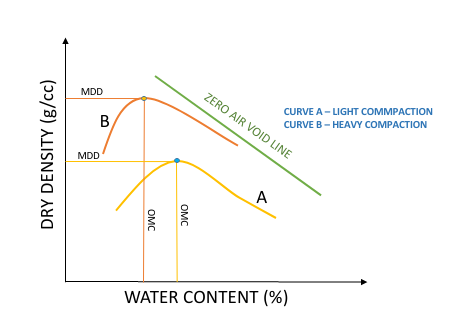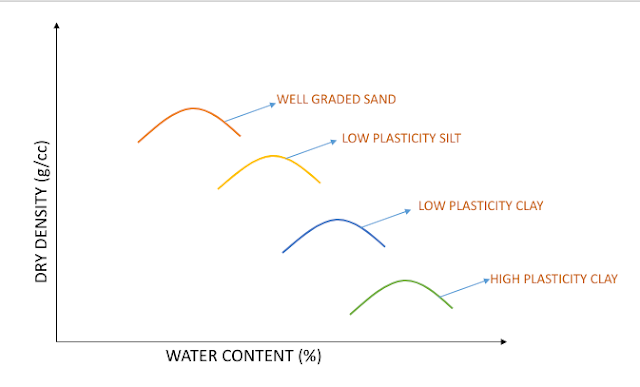FACTORS AFFECTING COMPACTION
The important factors affecting compaction are,
1) Water content
2) Amount of compaction
3) Type of soil
4) Method of compaction
5) Thickness of layer
6) Saturation line
7) Admixtures
8) Stone content
1) Water Content :
At low water content, the soil is stiff and offers more resistance to compaction.
As the water content is increased, the soil particles get lubricated.
The soil mass becomes more workable and the particles have closer packing.
The dry density of soil increases with an increase in water content till the optimum water content is reached.
At that stage, the air voids attain approximately a constant volume.
With further increase in water content, the air voids do not decrease, but the total voids (air + water) increase and the dry density decreases.
2) Amount of Compaction :
The amount of compaction greatly affects the maximum dry density and optimum moisture content of a given soil.
The effect of increasing the compactive energy result in an increase in maximum dry density and decrease in the optimum moisture content.
However, the increase in MDD does not have a linear relationship with increase of compactive effort.
As seen from figure , in case of heavy compaction (Curve B), MDD is more and OMC is less compared to light compaction (Curve A).
3) Type of soil :
The maximum dry density achieved depends upon the type of soil.
The maximum density and optimum moisture content for different soils are shown in figure.
In general coarse grained soils can be compacted to higher dry density than fine grained soils.
A well graded sand attains a much higher dry density than a poorly graded soil.
Cohesive soils have high air voids.
These soils attain a relatively lower maximum dry density as compared with the cohesionless soils.
4) Method of compaction :
The dry density achieved also depends upon the method of compaction.
For the same amount of compactive effort, the dry density will depend upon whether the method of compaction utilizes kneading action, dynamic action or stationary action.
Different methods of compaction give their own compaction curves.
5) Thickness of layer :
In the compaction of soils the thickness of soil layer also play an important role.
Normally the thickness of layer in the laboratory is kept 30 to 40 mm, while in the field the thickness of soil layer is kept about 200 to 300 mm.
The lesser thickness of soil layer gives higher dry density.
6) Saturation line :
If all the air voids are removed from the soil by compaction, the soil becomes fully saturated and higher maximum dry density is achieved.
Therefore, saturation below 100 % results in lower maximum dry density.
Practically 100% saturation is not possible.
7) Admixtures :
The compaction characteristics of the soils are improved by adding some admixtures.
The most commonly used admixtures are lime, cement and bitumen.
8) Stone content :
With addition of aggregates of 20 to 30 mm size up to 40% volume, the density of soil increases.


